Now that the journey time from London to Folkestone has been reduced to less than an hour (if you take an expensive high-speed train from St Pancras), it might appear that the Kent town is positioning itself to usurp Brighton as the location of London-on-sea; one gallery on the Old High Street suggesting that its locale is now ‘like Zone 10’. However, I’m relieved to report that there is, as yet, relatively little evidence of the Londonification of Folkestone, and one feels that the town embodies a heartening resistance to full-scale ‘regeneration’ – all too often a euphemism for what ends up amounting to a process of homogenisation. For now, Folkestone remains as characterful as ever, as well as retaining a sense of its being just slightly out of the way - a feeling that is reflected, indeed exaggerated, in the title and theme of its second Triennial of contemporary art: ‘A Million Miles from Home’.
Inevitably, many of the works on show bear only a loose connection to this theme, although one or two certainly encapsulate it. In particular, Nikolaj Larsen’s video installation Promised Land is suffused with an exploration of many of the theme’s overtones: dislocation, alienation, and the yearning for a home that remains almost, but not quite completely, out of reach. Installed in a disused seafront café near the harbour, three large video screens show us carefully arranged footage of mainly Iranian and Afghan migrants squatting around Calais, whose lives revolve around their hopes and attempts to smuggle themselves into the UK through Dover. From their squalid shelters and encampments the migrants relate the journeys that have brought them this far, and describe their repeated efforts to complete the final leg by conquering this last obstacle, represented by the floodlit expanse of the seemingly impenetrable ferry terminal, strikingly shot by Larsen to make it seem like a place of both hostility and indifference. We hear also of those who have succeeded in getting to England, and the ambivalence that accompanies the arrival in this ‘promised land’: the severing of friendships forged in the grim but comradely circumstances of the camps, and the suggestion that it is merely a different kind of alienation that may await those reaching the UK. As much an important piece of documentary as it is a work of art, it is one of the most accomplished works in the Triennial, and almost certainly the most powerful.
A few minutes walk away, in another disused space – the old Folkestone Harbour railway station – Paloma Varga Weisz’s sculpture Rug People engages, more obliquely, with the same subject: ‘all those people, filled with hope, who are desperately trying to make it over to England and the trials and tribulations they endure in order to get there’. A large rug has been thrown over the rusting train tracks, upon which stands a plinth-like structure supporting five large busts, their heads slumped, their expressions world-weary and forlorn. Facing away from each other, looking out in all directions, these five anonymous figures feel somehow all the more alone for their shared pedestal, as though what it is they share is an experience that cannot be shared – one of enduring hardship and isolation. Whilst the piece is undoubtedly a thoughtful tribute to those itinerant masses seeking out a better life in a different land, I would perhaps question the choice of location, for the reason that the disrepair of the railway station itself makes for such a fascinating and poignant spectacle, that it quickly draws you away from Weisz’s sculpture, making her work play second fiddle to the dramatic semi-dereliction of the station’s crumbling architecture and its well-known historical associations (the embarkation point for World War I troops, and more recently a stop on the Orient Express). This is only a minor quibble though: whilst I think the piece might have worked even better somewhere else around the port/harbour area, the whole thing – station and sculpture – makes for an exceptionally rich and resonant experience.
As in the first Triennial, the harbour itself is once again used as the location for an artwork, and in a not dissimilar manner. Three years ago, for his very effective piece Foreshore, Robert Kusmirowski installed timber structures on the harbour bed that were alternately revealed and hidden by the movements of the tide. On this occasion, Tonico Lemos Auad has done the same sort of thing with tall wooden posts, some having ledges upon which stand totem-like figurines called ‘Carrancas’ – figureheads found on Brazilian fishing boats that are meant to ward off evil spirits at sea. Of course, it takes the Triennial catalogue to explain about this, which also inevitably goes into the artist’s thinking behind the work in some detail. However, commentary or no commentary, I found myself entirely unmoved by this piece, despite my efforts to engage with it at various different stages of the tide. Perhaps it suffers by comparison to Kusmirowski’s clever and haunting work from 2008.
Conversely, one of the low points of the first Triennial was the underwhelming piece that merely amounted to covering the Martello tower on the East Cliff in nylon netting, and I had been quite excited when I heard what Cristina Iglesias had done this time around with the town’s other Martello tower. This second tower, in the West, has been totally obscured by ivy for a number of years, and it was only possible to see it – or at least its ivy-covered form – by penetrating some undergrowth. Iglesias’s intervention consists of a kind of walkway she has installed through the undergrowth, leading to an open viewing platform that looks out over the ivy-covered tower and the overgrown patch of land in which it stands. It had sounded like a marvellous conceit, so I had high expectations, and these were only partially dashed by the reality of the piece. The experience of entering Iglesias’s walkway from the path and emerging out over a markedly different environment does have more than a touch of re-enchantment about it, reminding you of the ever-present potential to suddenly come upon interesting, overlooked spaces in the midst of seemingly unprepossessing surroundings. Only one person at a time can enter the walkway (not that there was anyone else there anyway when I went), and it is very pleasing to stand and gaze out at this peaceful, slightly mysterious little wilderness - a kind of secret garden, albeit one mostly filled with nettles. It’s also significant that after attaining this privileged spot, the tower itself remains hidden from view behind its foliage, and the ground around it remains inaccessible, as though we are being teased with a brief glimpse of a kind of elysian scene that must forever remain out of reach. Indeed, as someone who isn’t averse to the occasional bit of light trespassing in order to roam in these sorts of neglected spaces, I searched for some time for a way in to the grounds in which the tower stands, but to no avail. The work’s only disappointing aspect is the walkway itself: it’s just quite ugly. In order to supposedly blend in with the scenery, the outside is made of stainless steel so as to reflect the surrounding greenery, and the inside is lined with horribly cheap-looking resin that’s been moulded to look like vegetation, but just looks tacky. Its overall appearance falls so far short of its professed intention that it cannot be judged a success. It feels like Iglesias has simply done far more than she needed to do; a lighter touch would have made for a more harmonious intervention.
When it comes to light-touch interventions, they often don’t come much lighter than those of Martin Creed (whose oeuvre famously includes Work No. 79: Some Blu-Tack kneaded, rolled into a ball, and depressed against a wall). It’s difficult to say what is frequently so satisfying about his work: is it just its joyous, cheeky, childlike simplicity, or is it that, like so much great art (not that I would necessarily describe all of Creed’s work as ‘great’), it operates on a level that defies commentary? Creed’s sound piece for the Triennial is to be heard by taking a trip on the Leas Water Lift, the Victorian funicular railway that links the cliff-top with the beach. For the duration of the short journey, a recording of a string quartet fills the small lift, playing a simple descending scale for the descent, and – yes, you guessed it – a simple ascending scale for the ride back up. I’d never taken the lift before, which recently reopened following restoration, and it’s already rather good fun as it is, but Creed’s well-judged piece augments it delightfully. As with much of his work, it made a great big smile spread involuntarily across my face. It was also enjoyable to see people’s reactions as the strings swelled up, as nothing alerts embarking lift-goers to this added extra. On the trips I made (once down and later on up again – it’s a quid a pop), most passengers just appeared to assume it was a permanent feature, and why not?
Stepping out at the bottom of the lift, you come almost immediately to the site where Folkestone’s amusement park once stood, now just a large expanse of tarmac. Positioned at the far edge of this empty space, just before the beach proper, is a terrific piece called Out of Tune by the artist A K Dolven, consisting of a decommissioned church bell suspended on a cable between two 20-metre high posts. The 16th century bell – rejected by the church for its tonal impurity - has been made to function anew, and anyone can come along (during opening hours) and give it a hearty toll, and listen to its plangent tone ring out across the bleak strand. The bell makes a very pleasing, slightly muffled sound and works perfectly in this location: its repeated dongs seeming to lament the area’s disappearances, and heightening the palpable sense of absence that suffuses this place. At the same time though, there is also something defiant about it, as though this solitary bell – not only out of tune but also exiled from the place where it belonged – is boldly enunciating a certain tenacity, and the potential of new beginnings: there is a ring of reinvention about it. It is this duality, and the fact that the unusual, elegant structure looks so striking against the sea and the sky, that makes Dolven’s piece so compelling.
A short walk away up the Road of Remembrance, conventional church bells peal out from the Church of St. Mary and St. Eanswythe, a peaceful haven that’s delightful to stumble upon, nestled as it is in some very pleasant grounds between town centre and cliff. Inside can be found Hew Locke’s contribution to the Triennial: dozens of model boats of all shapes, sizes and colours, suspended from the roof of the nave (a word, Locke tells us, which derives from navis, the Latin for ship, on account of its shape), all facing the same direction, like a congregation, towards the altar. It is from there that this brightly coloured fleet is best viewed, where it appears like some joyfully eccentric, benevolent armada, caught in suspended animation as it sails inexorably towards its heavenly calling. Indeed, the work’s comforting symbolism sits easily with its surroundings, without connoting an unambiguously religious or eschatological reading; the stilled motion of the piece seeming to emphasise the journey, in all its splendid diversity, as opposed to the destination.
There is lots of other excellent work here. Zineb Sedira’s video piece – installed in an intriguing little recess in the cliff, once used for storing deckchairs – focuses on two Algerian lighthouses and their keepers. I still remember being captivated by Sedira’s film Out of Blue when I saw it a few years ago, and the main work here, Lighthouse in the Sea of Time, again showcases Sedira’s talent for sumptuous, poetic cinematography. Another video with a maritime theme has been produced by the artist collective Camp, in collaboration with the National Coastwatch Institution, in whose building at Copt Point the film is showing. The group rigged cameras up to NCI’s telescopes to record exactly what they see, over which we hear the NCI volunteers’ commentary. What are presumably the edited highlights of this comprise Camp’s hour-long video, and it makes for an unexpectedly engaging film, providing an insight into NCI’s surprisingly voyeuristic activities. I also very much liked Spencer Finch’s meditative piece The Colour of Water, a piece comprising four simple monochrome flags flying in Christchurch Gardens – the colour of the flags supposedly corresponding to the colour of the sea as observed that morning, the exact tone having been determined on a colour wheel that Finch has installed at a vantage point on the Leas promenade. Finally, the Folkestone-based art collective Strange Cargo have produced a fascinating book called Everywhere Means Something to Someone: a compendium of Folkestone residents’ memories and observations, each one linked to a specific place in the town. The result is a diverse topographical survey of the town, and although I sometimes yearned for more depth and reflection in the contributions, the book still feels like an important record; such a project should be instigated in every town and city in the country. It also embodies something which I think makes the whole Triennial cohere into something greater than the sum of its many parts: a thoughtful engagement with the minutiae and specificity of place, that succeeds in exposing and exploring Folkestone’s rich and unique topology.
David Foster
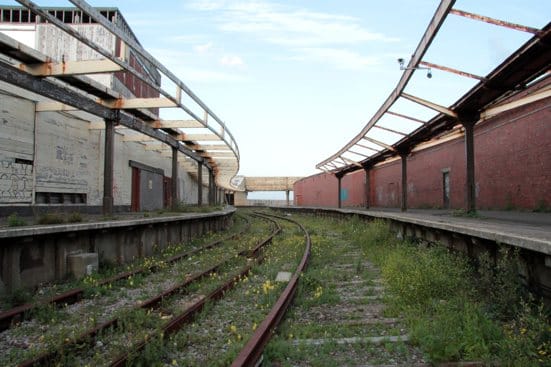
Disused Folkestone Harbour Station.
Photograph: David Foster
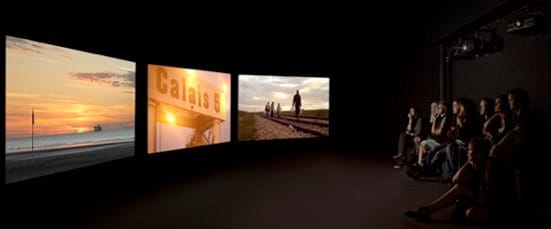
Nikolaj Larsen - Promised Land 2011
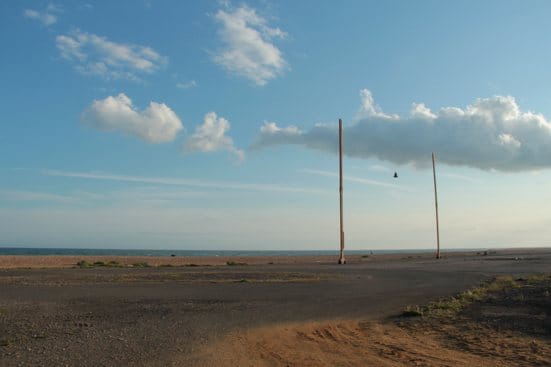
AK Dolven - Out of Tune
Photograph: David Foster
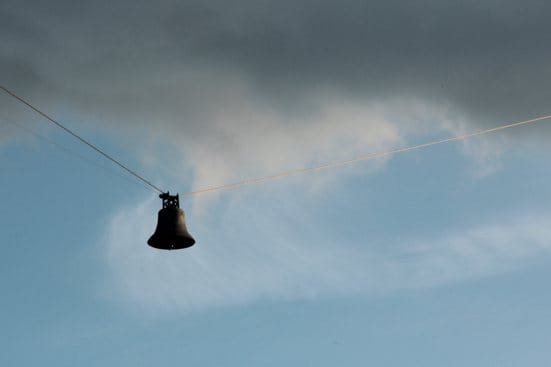
AK Dolven - Out of Tune (detail)
Photograph: David Foster
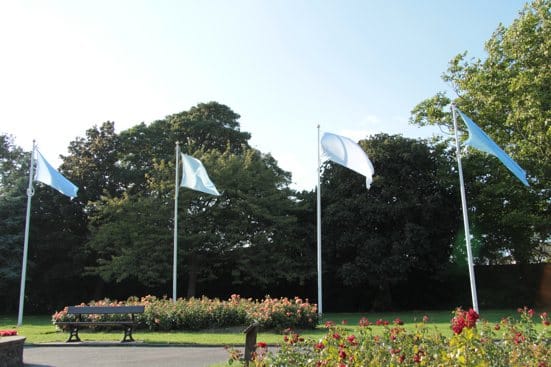
Spencer Finch - The Colour of Water
Photograph: David Foster